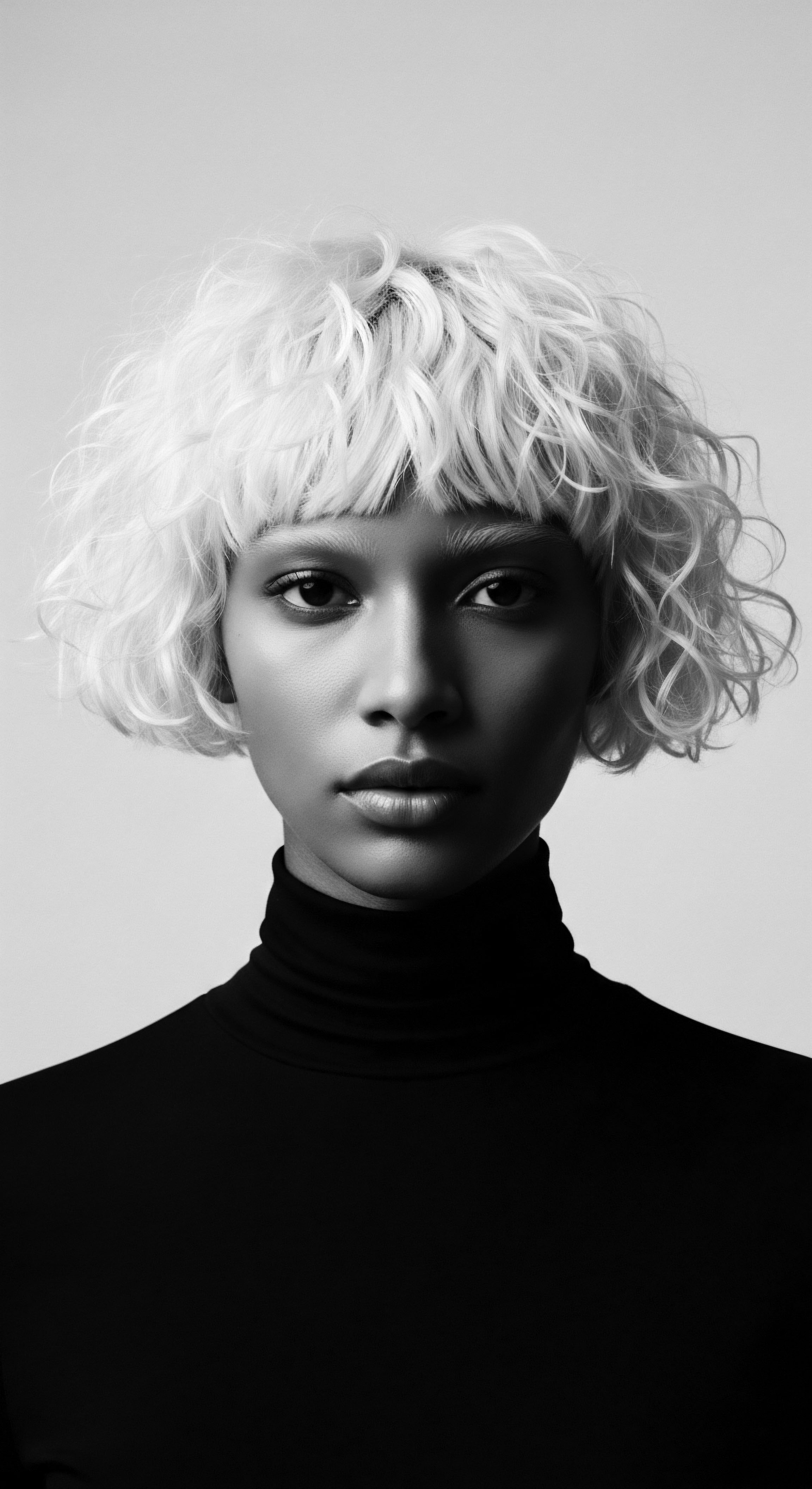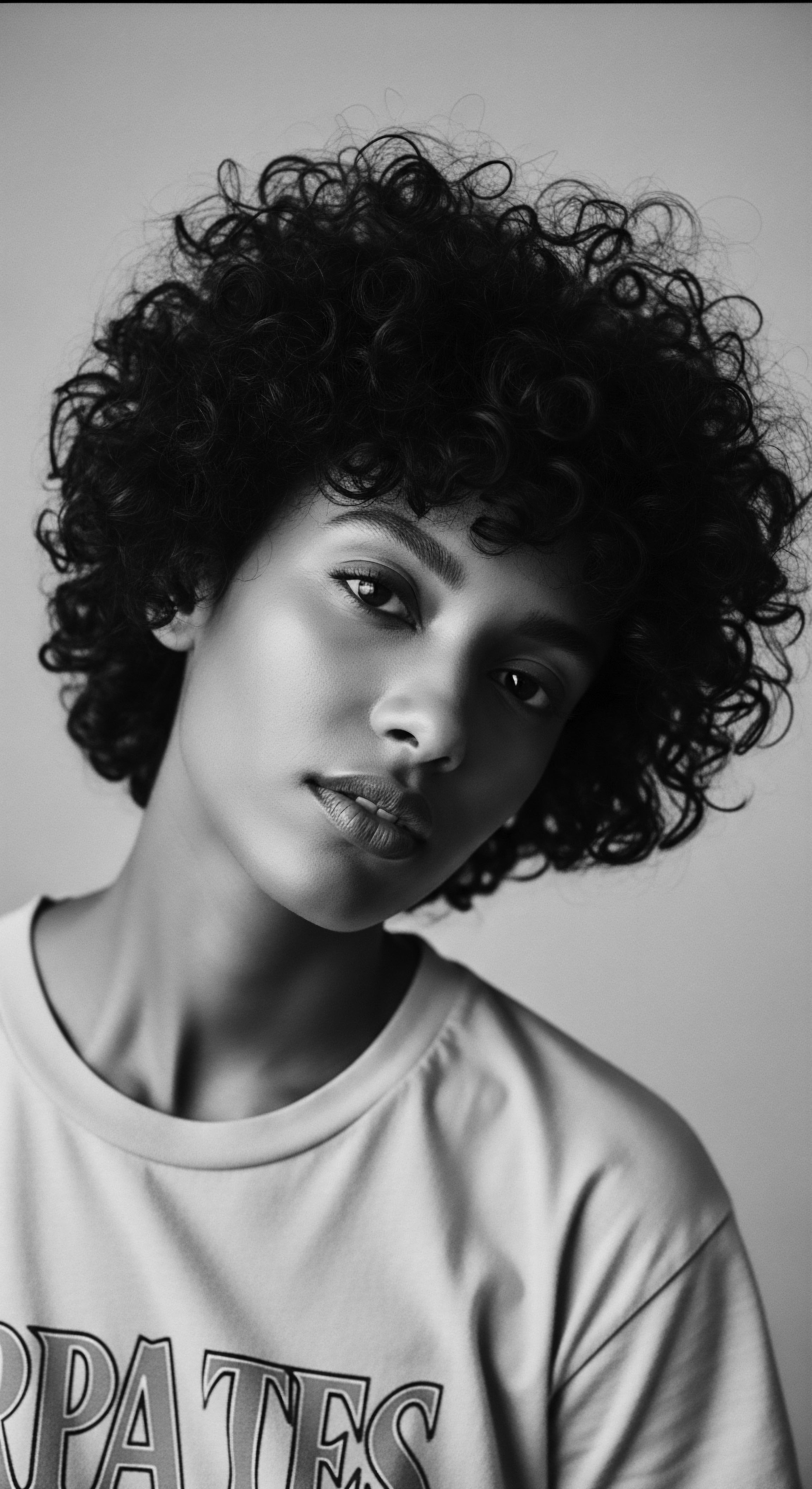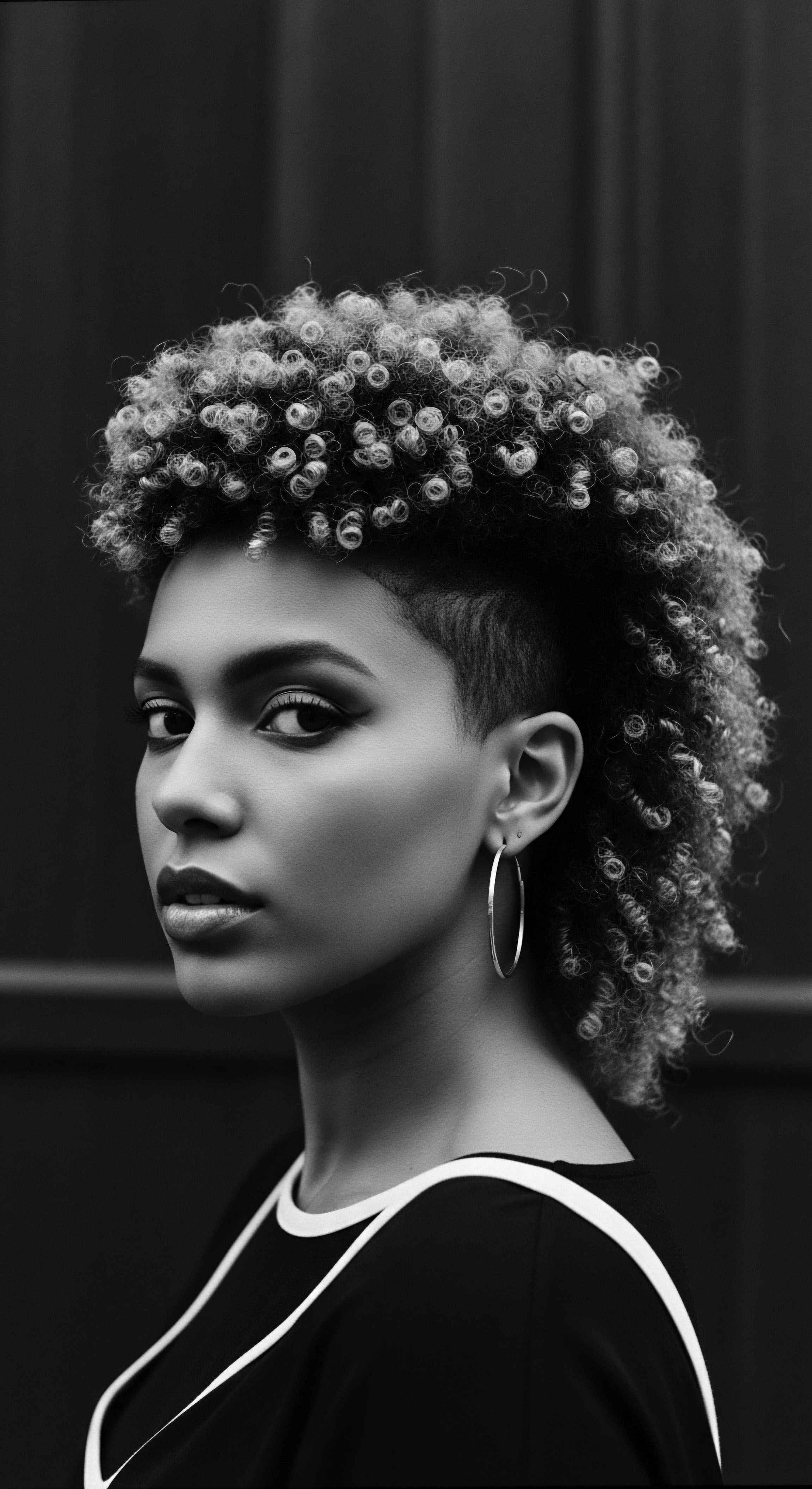
Roots
To walk this path with us, consider the very fabric of our being, how history lives within each curl, each coil, a silent testament to journeys taken and wisdom held. Textured hair, in its myriad expressions, carries the whispers of our ancestors, a living library of heritage etched into its very form. What historical hair practices supported the unique needs of coiled hair? This query reaches beyond mere styling; it calls forth a deeper understanding of biology, culture, and resilience intertwined across millennia.
The distinct nature of coiled hair, characterized by its elliptical shaft and numerous points of curvature, means natural oils from the scalp face a longer, more winding path to reach the entire strand. This anatomical reality necessitates a particular approach to care, one historically understood and practiced with remarkable ingenuity long before modern science articulated the precise mechanisms. Ancestral societies recognized this inherent need for moisture and protection, developing methods that supported the hair’s integrity and celebrated its unique architecture.

What Did Early Hair Anatomy Reveal?
The foundational understanding of hair, even without microscopes or chemical analyses, was deeply observational. Our forebears saw the hair’s tendency towards dryness, its response to moisture, and its capacity for intricate forms. They understood that coiled hair required gentle handling, consistent hydration, and styles that honored its inclination to shrink and coil.
This innate wisdom guided the development of their practices, transforming daily grooming into a ritual of preservation. The elliptical cross-section of coiled hair makes it prone to breakage, which the ancients intuitively countered with protective measures.
Ancient classifications of hair did not rely on scientific typologies but on observation of natural patterns and the visual cues associated with societal roles. Hair was a powerful communicator. In pre-colonial African societies, hair communicated a person’s identity, social role, age, marital status, tribal affiliation, and even spiritual beliefs. The very way hair grew from the scalp, its natural density, and curl pattern were all recognized within these communities as markers of lineage and belonging.
Hair, in ancestral communities, served as a profound visual language, signaling identity and belonging.

Understanding Coiled Hair Through a Heritage Lens
The language surrounding textured hair, even in ancient times, was rich with terms that described its various forms and the practices applied to it. While a formal lexicon as we know it did not exist, oral traditions and communal practices established a shared understanding. This collective knowledge ensured that techniques for cleansing, moisturizing, and styling were passed down through generations, each lesson a strand connecting past to present.
Hair growth cycles, though not scientifically charted, were implicitly understood within the rhythm of life. Hair was perceived as a living extension of self, influenced by diet, environment, and spiritual well-being. This holistic view meant that hair care was never isolated but interwoven with overall health and spiritual practices. For instance, archaeological evidence from ancient Egypt, the Kingdom of Kush, and various West African cultures points to hair as an expression of power, spirituality, and social cohesion.
Traditional hair care methods were inherently tied to environmental factors and available resources. The climate, with its humidity or aridity, dictated the types of natural ingredients gathered and the frequency of certain practices. Nutritional factors, derived from indigenous diets, also contributed to hair health, something our ancestors observed and utilized in their daily lives. The rich botanicals of African lands provided a diverse palette for hair nourishment and protection.
| Traditional Observation Hair's tendency to dry out quickly |
| Modern Scientific Understanding Elliptical hair shaft shape limits sebum distribution. |
| Traditional Observation Hair's need for gentle handling |
| Modern Scientific Understanding Coiled structure creates points of weakness, reducing tensile strength. |
| Traditional Observation Benefits of protective styling |
| Modern Scientific Understanding Minimizes manipulation and environmental exposure, reducing breakage. |
| Traditional Observation Hair as a mirror of overall health |
| Modern Scientific Understanding Nutritional status and systemic health affect hair growth and vitality. |
| Traditional Observation Ancestral wisdom intuitively understood the unique needs of coiled hair, echoed by modern scientific insights. |

Ritual
The historical hair practices supporting the unique needs of coiled hair extend into a realm where artistry meets utility. These traditions, passed down through generations, transformed the very act of hair styling into a profound cultural ritual. The hands that braided, twisted, and sculpted coiled hair were not merely styling tools; they were conduits of ancestral knowledge, preserving techniques that protected the hair while simultaneously communicating identity, status, and community narratives.
Protective styles stand as a testament to this enduring heritage. Styles such as braids, cornrows, locs, and Bantu knots, practiced across countless African societies for thousands of years, were not simply decorative. They served a vital function ❉ to shield the hair from environmental damage, reduce manipulation, and preserve moisture. This safeguarding aspect was crucial for hair types prone to dryness and breakage, a characteristic of many coiled hair textures.

What Forms Did Protective Styling Take?
The repertoire of protective styling was vast and varied, reflecting the diverse cultures from which they arose.
- Cornrows ❉ These intricate, tightly braided rows, often lying flat against the scalp, have a history spanning back to 3000 BC in Stone Age paintings in the Tassili Plateau of the Sahara. Beyond their practicality, cornrows were used to convey social status, age, marital status, or tribal affiliation. During the transatlantic slave trade, their significance deepened. Enslaved African women ingeniously braided rice seeds into their hair as a means of survival, and some even used cornrow patterns as coded maps to guide escape routes. This stark example powerfully illustrates how historical hair practices supported not just hair health, but survival and resistance.
- Braids ❉ Encompassing a wide array of styles from simple plaits to elaborate extensions with natural materials, braids were a cornerstone of hair care and cultural expression. They provided a method to manage and protect coiled hair, allowing for length retention and minimizing daily wear. The communal act of braiding often became a social ritual, a space for storytelling and sharing intergenerational wisdom.
- Locs ❉ Known for their spiritual meanings and association with warrior status, locs have a long history in African cultures, with evidence suggesting their presence as early as 500 BCE among Ethiopian Coptic Orthodox Church priests. They represent a profound connection to the divine and a natural, undisturbed state of being.
- Bantu Knots ❉ Originating from the Bantu people of Southern Africa, these coiled knots symbolize pride and are often worn during rites of passage ceremonies, offering protection and definition to the hair.
These styles, deeply embedded in cultural heritage, reduced the need for frequent detangling and exposure to harsh elements, thus protecting fragile strands.
Protective styles are ancient technologies, safeguarding hair while inscribing cultural narratives upon the scalp.

Tools of the Ancestors and Their Modern Echoes
The tools employed in these historical practices were often crafted from natural materials, reflecting a harmony with the environment. Wide-toothed combs, likely fashioned from wood or bone, were essential for detangling coiled hair gently, reducing breakage that could result from coarser implements. Natural hair oils, butters, and herbs served as the primary conditioning and styling agents, often applied with hands that understood the hair’s texture and needs.
The transformation of hair through these techniques was not merely aesthetic. It was a conscious act of adornment that served multiple purposes. Adornments like beads, cowrie shells, gold, and plant fibers were often woven into hairstyles, signifying wealth, social standing, marital status, or religious devotion. This practice highlights how hair styling was an integrated part of a person’s identity and their connection to their community.
In reflecting upon these traditions, we discern a continuum between ancient care and modern protective styling. While contemporary products and tools have evolved, the underlying principles of moisture retention, minimal manipulation, and celebration of natural texture persist. The very concept of “low-maintenance” styling for coiled hair today finds its lineage in these age-old methods designed for practicality and longevity.

Relay
The deeper exploration of historical hair practices supporting coiled hair reveals not merely routines, but a sophisticated system of holistic care, deeply informed by ancestral wisdom. These regimens recognized the intimate connection between hair health, spiritual well-being, and community identity. What might seem like simple grooming was, in fact, a complex interplay of elemental biology, natural resources, and profound cultural belief.

How Did Traditional Care Routines Prioritize Moisture?
At the heart of ancestral care for coiled hair lay a profound understanding of its need for moisture. Given the hair’s structure, which makes it challenging for natural scalp oils to travel down the strand, dehydration is a persistent concern. Traditional practices developed ingenious methods to counter this.
Oiling and greasing the scalp and hair were common practices, using a variety of natural oils and butters to seal in hydration and maintain hair elasticity. This was a direct response to the hair’s unique physiological requirements.
Ancestral ingredients formed the cornerstone of these moisturizing rituals.
- Shea Butter ❉ A staple across West Africa, shea butter is renowned for its deeply nourishing and moisturizing properties, helping to reduce frizz and breakage while maintaining flexibility.
- Chebe Powder ❉ Originating from Chad, this powder is a blend of lavender crotons, stone scent, cherry seeds, cloves, and raisin tree sap. It was traditionally used to increase hair thickness and, critically, to retain moisture between washes, preventing dryness and breakage. Its anti-inflammatory properties also benefited scalp health.
- Plant Oils ❉ Indigenous oils such as coconut, argan, avocado, jojoba, and olive oil were utilized for pre-shampoo treatments, hot oil treatments, and daily conditioning. These oils were warmed and applied, often under coverings to enhance penetration, a method still recognized for improving hair strength and moisture.
- Rice Water ❉ An ancestral treatment, particularly noted in Asian traditions but with parallels in broader natural hair care, rice water is rich in amino acids, vitamins, and minerals. It was used to strengthen hair, make it smoother, and reduce frizz by tightening the cuticles.
- Aloe Vera ❉ Valued for its hydrating, soothing, and pH-balancing properties, aloe vera was a common ingredient in traditional hair formulations, contributing to scalp health and hair shine.
- Herbal Infusions ❉ Plants like neem, sage, rosemary, and nettle were steeped to create rinses or blended into pastes, addressing concerns such as dryness, dandruff, and stimulating hair growth.
These methods, though centuries old, align remarkably with modern hair science, validating the efficacy of ancestral care practices.

What Nighttime Rituals Supported Hair Health?
The care of coiled hair did not cease with the setting sun. Nighttime rituals were as integral to its well-being as daytime styling. The use of headwraps, scarves, and later, bonnets, is a practice deeply rooted in Black beauty rituals and heritage.
These coverings were not merely fashion statements; they provided essential protection against friction, moisture loss, and tangling during sleep. This practice ensured that the intricate styles created during the day lasted, preserving the integrity of the hair and extending the life of labor-intensive techniques.
Nighttime protection of coiled hair, a seemingly simple act, embodies centuries of cultural wisdom and practical hair preservation.
Historically, head coverings also carried immense cultural and symbolic weight. In many African communities, headwraps indicated marital status, age, or social standing. During the era of slavery, they became symbols of dignity and resistance, protecting hair from harsh conditions while simultaneously defying European beauty standards. The consistent thread across these historical uses is the profound understanding of coiled hair’s fragility and the concerted effort to shield it.

How Did Ancestral Wisdom Address Hair Challenges?
The holistic approach to hair health in ancestral societies also extended to problem-solving. Issues like dryness, breakage, and scalp irritation were addressed through a combination of topical applications and an understanding of internal wellness. If a woman’s hair appeared “undone” in some Nigerian communities, it could signify depression or illness, emphasizing the link between hair and overall well-being.
The resilience of textured hair heritage is perhaps nowhere more visible than during periods of oppression. Despite the deliberate attempts during the transatlantic slave trade to strip Africans of their identity by shaving heads and denying access to traditional hair care tools and ingredients, individuals found ways to maintain connection to their hair. Forced to improvise, enslaved people resorted to using whatever was available, including bacon grease or butter, as lubricants, and crude implements for combing. This adaptation speaks volumes about the enduring spirit and the deep significance of hair within these communities.
| Ingredient Shea Butter |
| Traditional Use Deep conditioning, moisture sealant |
| Contemporary Parallel/Benefit Moisturizer, frizz control, elasticity. |
| Ingredient Chebe Powder |
| Traditional Use Length retention, moisture locking |
| Contemporary Parallel/Benefit Reduces breakage, promotes thickness, scalp health. |
| Ingredient Rice Water |
| Traditional Use Hair strength, shine |
| Contemporary Parallel/Benefit Strengthens fiber, adds shine, reduces frizz, scalp health. |
| Ingredient Plant Oils |
| Traditional Use Lubrication, hot oil treatments |
| Contemporary Parallel/Benefit Moisture retention, improved strength, scalp circulation. |
| Ingredient These ancestral ingredients continue to shape contemporary hair care, validating timeless wisdom. |
The philosophical underpinnings of ancestral hair care positioned hair as more than just a physical attribute; it was a conduit for spiritual energy, a connection to ancestors, and a powerful symbol of self. This reverence ensured that practices supporting coiled hair were meticulously preserved and adapted, safeguarding a vital aspect of cultural identity and heritage across time.

Reflection
As we close this exploration of historical hair practices supporting the unique needs of coiled hair, a profound truth settles upon us ❉ this journey through ancestral wisdom is not merely an academic exercise. It is a remembrance, a reclamation of a living heritage that pulses within each strand. The resilience of coiled hair, so often misunderstood or marginalized in dominant beauty narratives, finds its deepest strength in the historical care rituals that prioritized its very being.
From the careful application of rich, natural butters to the intricate artistry of protective styles, our ancestors laid a foundation for understanding and honoring coiled textures. These practices were not just about aesthetics; they were about survival, identity, community, and spiritual connection. The whispers of these traditions echo in every coil, a testament to enduring creativity and profound self-knowledge.
Our understanding of coiled hair, its heritage, and its care, forms a living archive. It invites us to remember the ingenuity that transformed challenge into beauty, scarcity into resourcefulness, and oppression into powerful expressions of identity. The legacy of these practices guides us still, urging a harmonious blend of scientific understanding and ancestral reverence. It reminds us that our hair is an unbound helix, capable of voicing deep histories and shaping vibrant futures, always connected to its source.

References
- Afriklens. (2024). African Hairstyles ❉ Cultural Significance and Legacy.
- Afriklens. (2025). The Evolution of African Hairstyles in Cultural Celebrations.
- Africa Imports. (No date). Traditional African Secrets For Long And Healthy Hair.
- Assendelft. (No date). Pre-Colonial African Hairstyles ❉ A Journey Through Time and Culture.
- BLAM UK CIC. (2022). The History of Black Hair.
- Chebeauty. (2024). Nourish Your Roots ❉ Essential Care Guide for Dry Afro Hair Scalp.
- CurlyNikki. (No date). Caring for Your Natural Hair in Humidity.
- Khumalo, N.P. (2008). On the history of African hair care ❉ More treasures await discovery. J. Cosmet. Derm. 7, 231.
- Kodd Magazine. (No date). African hair tells a story and inspires the future.
- Livara Natural Organics. (2023). Black History Month ❉ The Rich History of Our African Hair.
- MDPI. (2022). Afro-Ethnic Hairstyling Trends, Risks, and Recommendations.
- MDPI. (2024). Cosmetopoeia of African Plants in Hair Treatment and Care ❉ Topical Nutrition and the Antidiabetic Connection?
- NativeMag. (2020). Examining the history and value of African hair.
- Niwel Beauty. (2024). Rice water for hair, an ancestral treatment.
- OkayAfrica. (No date). A Regional Walk Through The History of African Hair Braiding.
- Pretty Curly Girl. (2025). Top 5 Natural Ingredients for Strong, Healthy, and Bouncy Curls.
- PubPub. (2023). Coils & Curls ❉ A Mathematical Tapestry of Black Hair – Algorithmic Pattern.
- ResearchGate. (2024). Cosmetopoeia of African Plants in Hair Treatment and Care ❉ Topical Nutrition and the Antidiabetic Connection?
- Safo Hair. (2024). Unveiling the Significance of Hairstyles in Black Communities.
- Sartorial Magazine. (2025). Braids, Locs, and Beyond ❉ The Beauty and History of Protective Styles.
- Smith Scholarworks. (No date). Black women’s natural hair care communities ❉ social, political, and cultural implications.
- The African American Museum of Iowa. (No date). History of Hair.
- The Gale Review. (2021). African Hairstyles – The “Dreaded” Colonial Legacy.
- The Library of Congress. (No date). Heavy is the Head ❉ Evolution of African Hair in America from the 17th c. to the 20th c.
- The Zoe Report. (2024). The Silk Bonnet’s History Is Rooted In Black Beauty Rituals.
- Trill Mag. (2024). The Cultural Roots of Your Summer Braids.
- Vanderbilt Library Research Guides. (2025). Black Hair in Children’s Literature ❉ Fiction Picture Books.
- Wilderness. (2015). The history & meaning of head wraps across Africa.
